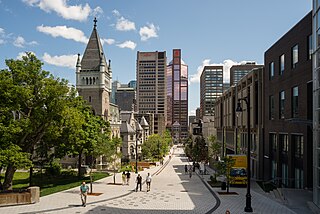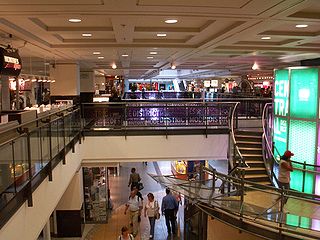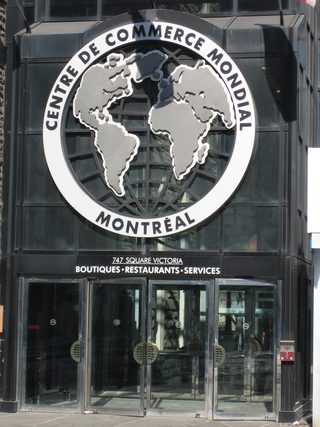
The architecture of Montreal, Quebec, Canada is characterized by the juxtaposition of the old and the new and a wide variety of architectural styles, the legacy of two successive colonizations by the French, the British, and the close presence of modern architecture to the south. Much like Quebec City, the city of Montreal had fortifications, but they were destroyed between 1804 and 1817.

RÉSO, commonly referred to as the Underground City, is the name applied to a series of interconnected office towers, hotels, shopping centres, residential and commercial complexes, convention halls, universities and performing arts venues that form the heart of Montreal's central business district, colloquially referred to as Downtown Montreal. The name refers to the underground connections between the buildings that compose the network, in addition to the network's complete integration with the city's entirely underground rapid transit system, the Montreal Metro. Moreover, the first iteration of the Underground City was developed out of the open pit at the southern entrance to the Mount Royal Tunnel, where Place Ville Marie and Central Station stand today.

Place Ville Marie is a large office and shopping complex skyscraper in Downtown Montreal, Quebec, Canada, comprising four office buildings and an underground shopping plaza. The main building, 1 Place Ville Marie, was built in the International style in 1962 as the headquarters for the Royal Bank of Canada. While RBC's corporate headquarters and the majority of its management operations have been based in Toronto's Royal Bank Plaza since 1976, Place Ville Marie remains RBC's head office, a distinct title from its corporate headquarters. It is a 188 m (617 ft), 47-storey, cruciform office tower. The complex is a nexus for Montreal's Underground City, the world's busiest, with indoor access to over 1,600 businesses, numerous subway stations, a suburban transportation terminal, and tunnels extending throughout downtown. A counter-clockwise rotating beacon on the rooftop lights up at night, illuminating the surrounding sky with up to four white horizontal beams that can be seen as far as 50 kilometres (31 mi) away. This beacon is not considered as a NAVAID for aviation purposes.

1000 de la Gauchetière is a skyscraper in Montreal, Quebec, Canada. It is named for its address at 1000 De la Gauchetière Street West in the downtown core. It is Montreal's tallest building as per the height definition of the National Building Code of Canada that is used by the city of Montreal, which excludes spires. For international comparison, spires are included as per the Council on Tall Buildings and Urban Habitat's most widely used height definition for building height and the building is thus the second tallest building as per this definition. It rises to the maximum elevation approved by the city at 232.5m above mean sea level with a total height from the average ground level around first floor to roof of 205m (673ft) and 51 floors. A popular feature of the building is its atrium, which holds a large ice skating rink. The building was not subject to the 1992 municipal maximum height of 200m because it was finished in 1992.

McGill station is a Montreal Metro station in the borough of Ville-Marie in the downtown core of Montreal, Quebec, Canada. It is operated by the Société de transport de Montréal (STM) and serves the Green Line. The station opened on October 14, 1966, as part of the original network of the Metro.

CIBC Tower is a 187 m (614 ft) 45-storey skyscraper in Montreal, Quebec, Canada. The International Style office tower was built by Peter Dickinson, with associate architects Ross, Fish, Duschenes and Barrett, and was the city's tallest building from 1962 to 1963. The building holds offices for the Canadian Imperial Bank of Commerce, the corporate law firm Stikeman Elliott, the Canadian accounting firm MNP LLP, as well as numerous other businesses.

1250, boulevard René-Lévesque is a 199-metre (653 ft), 47-story skyscraper in Montreal, Quebec, Canada. It is the second tallest building in Montreal and the province of Quebec, when the spire is excluded, as per the height definition used by the city of Montreal. For international comparison the spire is included as per CTBUH, which brings the height to 226.5m and becomes the tallest building in Montreal and the province of Quebec. The building was designed by Kohn Pedersen Fox Associates for IBM Canada and Marathon Realty, hence the former name "IBM-Marathon Tower". It is now named for its address at 1250 René Lévesque Boulevard West, in the Ville-Marie borough of Downtown Montreal. It is adjacent to the Bell Centre and Windsor Station to the south, and stands on the site of the former American Presbyterian Church. It is connected to the Bonaventure metro station and the underground city network.

The Quartier international de Montréal (QIM) or Montreal's International District is a district of the Ville-Marie borough in the city's downtown core of Montreal, Quebec, Canada. It is roughly bordered by René-Levesque Boulevard to the north, Notre-Dame Street to the south, De Bleury/Saint-Pierre Street to the east and Robert-Bourassa Boulevard to the west. The Palais des congrès building lying just east of the district is also usually comprised in it. Constructed dispersedly between 1965 and 1985 in place of older colonial housing blocks, the district underwent major urban renewal as a central business district in 2000–2003.

The KPMG Tower, formerly Maison des Coopérants or Place de la Cathédrale, is a 34-storey skyscraper in downtown Montreal, Canada, that was completed in 1987. It is at 600 de Maisonneuve Ouest and has an official height of 146 m (479 ft). The building is owned and operated by BentallGreenOak.

De Maisonneuve Boulevard is a major westbound boulevard located in downtown Montreal, Quebec, Canada. It is named after the founder of Montreal, Paul Chomedey de Maisonneuve. It is a one-way street westbound.

The Olympic Village is a twin-tower structure in Montreal, Quebec, Canada, built as the athletes' residence for the 1976 Summer Olympics. Designed by architects Roger D'Astous and Luc Durand, it was built massively over budget by a consortium of architects, including Joseph Zappia, who was later convicted of fraud in connection with his involvement with the building.

500 Place d'Armes is an International style building on the historic Place d'Armes square in Old Montreal quarter of Montreal, Quebec, Canada.
René G. Lépine was a Canadian real estate developer and philanthropist. Lépine was the chairman of Groupe Lépine, a real estate development and investment firm he founded in 1953. He is widely considered one of the most influential French Canadian real estate developers of his time. His companies developed over $5 billion of real estate in Canada and the United States since the 1960s. He also owned a portfolio of multifamily and retail properties in Montreal and Ottawa. Lépine developed many buildings considered landmarks in Montreal, including the Olympic Village and Le Sanctuaire du Mont-Royal. Lépine is also credited with having developed the first condominiums in Montreal in 1981.

Complexe Maisonneuve is an office building complex in Montreal, Quebec, Canada. Complexe Maisonneuve is located on De la Gauchetière Street West between University Street and Beaver Hall Hill. It is situated facing Victoria Square in the Quartier international district of Downtown Montreal, and is linked to Montreal's Underground City and Square-Victoria-OACI Station on the Montreal Metro. The complex consists of two buildings, the 600 de La Gauchetière and the 700 de La Gauchetière which were built at the same time in 1983 but are owned by different real estate companies.

Le Cartier is a high-rise apartment building in Montreal, Quebec, Canada. It is located at 1115 Sherbrooke Street West at the corner of Peel Street and Sherbrooke Street West in the Golden Square Mile area of Downtown Montreal. When completed in 1964, Le Cartier was the tallest apartment building in Canada and throughout the Commonwealth. It is 32 stories above ground and stands at 98 metres (322 ft) tall. It contains four basement floors, four elevators and 188 units.
Le Sir George Simpson is a Condominium Private offices located at Quebec, Canada. The construction started in 2006 and was completed in 2010. The Sir George Simpson project was developed by Rene Lépine Sr., Management Groupe Lépine.
Le Sanctuaire du Mont-Royal is a multi-phase condominium, commercial, athletic and medical complex located in the Côte-des-Neiges neighbourhood near the Outremont neighbourhood of Montreal, Quebec, Canada. The complex consists of seven phases (buildings), which contain a total of 925 residential units. Le Sanctuaire was built by Montreal-based luxury developer René Lépine Sr., head of Groupe Lépine.

The IA Tower, originally called Industrial Life Tower, is a 23 stories high rise building located in downtown Montreal, Quebec, Canada. Inaugurated in 1986, it was one of the first postmodernist high rises built in downtown Montreal.















